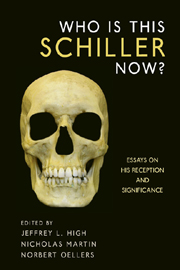Book contents
- Frontmatter
- Contents
- Foreword
- Acknowledgments
- List of Abbreviations
- Introduction: Why Is This Schiller [Still] in the United States?
- Part I Schiller, Drama, and Poetry
- Part II Schiller, Aesthetics, and Philosophy
- Part III Schiller, History, and Politics
- Part IV Schiller Reception — Reception and Schiller
- 17 Schiller and the Gothic — Reception and Reality
- 18 Schiller's Plays on the British Stage, 1797–1825
- 19 From Martyr to Vampire: The Figure of Mary Stuart in Drama from Vondel to Swinburne
- 20 A Chapter of Schiller in America: The First World War and Volume 3 of Kuno Francke's Edition of The German Classics
- 21 The Reluctant Recruit? Schiller in the Trenches, 1914–1918
- 22 Schiller — Kommerell — George. Eine Konstellation der Moderne
- 23 Was sagte dieser Schiller (damals)? Schillers Antworten auf seine Kritiker nach 1945
- Part V Schiller Now
- Notes on the Contributors
- Index
18 - Schiller's Plays on the British Stage, 1797–1825
from Part IV - Schiller Reception — Reception and Schiller
Published online by Cambridge University Press: 05 February 2013
- Frontmatter
- Contents
- Foreword
- Acknowledgments
- List of Abbreviations
- Introduction: Why Is This Schiller [Still] in the United States?
- Part I Schiller, Drama, and Poetry
- Part II Schiller, Aesthetics, and Philosophy
- Part III Schiller, History, and Politics
- Part IV Schiller Reception — Reception and Schiller
- 17 Schiller and the Gothic — Reception and Reality
- 18 Schiller's Plays on the British Stage, 1797–1825
- 19 From Martyr to Vampire: The Figure of Mary Stuart in Drama from Vondel to Swinburne
- 20 A Chapter of Schiller in America: The First World War and Volume 3 of Kuno Francke's Edition of The German Classics
- 21 The Reluctant Recruit? Schiller in the Trenches, 1914–1918
- 22 Schiller — Kommerell — George. Eine Konstellation der Moderne
- 23 Was sagte dieser Schiller (damals)? Schillers Antworten auf seine Kritiker nach 1945
- Part V Schiller Now
- Notes on the Contributors
- Index
Summary
Samuel Taylor Coleridge's translation of Friedrich Schiller's The Piccolomini was published in London by Longman in April or May 1800, followed by, and bound together with, The Death of Wallenstein in June 1800. Extracts from Joseph Charles Mellish's translation of Schiller's Mary Stuart appeared in 1800, and Mellish's complete translation was published in 1801. As important landmarks in the British reception of Schiller, these two translations are all the more significant because both predate the publication of the original works in Germany. Because reception was affected by the revolution in France, the disparity between the stage performances on the one hand and the intellectual reception among critics and translators on the other was imposed by the very conditions of the stage at that period, foremost censorship and the prevailing preference for melodrama.
SAMUEL TAYLOR COLERIDGE'S translation of Friedrich Schiller's The Piccolomini was published in London by Longman in April or May 1800, followed by, and bound together with, The Death of Wallenstein in June 1800. Extracts from Joseph Charles Mellish's translation of Schiller's Mary Stuart appeared in The German Museum in 1800, and Mellish's complete translation was published by Cotta in London in 1801. As important landmarks in the British reception of Schiller, these two translations are all the more significant because both predate the publication of the original works in Germany. Because reception was affected by the revolution in France, and because of a tightening of theatre censorship, constraints on performance altered the usual time-lag in literary reception.
- Type
- Chapter
- Information
- Who Is This Schiller Now?Essays on his Reception and Significance, pp. 302 - 320Publisher: Boydell & BrewerPrint publication year: 2011

